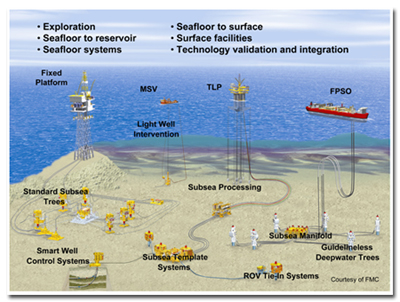|
Natural gas and crude oil provide 62% of our Nation's primary energy supply and will continue to do so for at least the next several decades, even as we transition to a more sustainable energy future. The natural gas resource estimated to exist within the United States is large, but because this resource is increasingly harder to produce, new technologies are required to extract it in a timely and environmentally sustainable manner to support a growing economy. This is also true for the domestic oil resource, much of which will need to be located and produced from very deep water, forced from residual pockets left in older reservoirs, or extracted from unconventional deposits, all of which are difficult to develop with existing technology, even at current prices.
|
 |
|
Ultra-deepwater architecture and technology. |
The explosion of the Deepwater Horizon in the Gulf of Mexico is a stark reminder of the risks associated with operating in the deepwater. Industry has had impressive success in innovating new technologies to find, develop and commercialize oil and gas in the deepwater, but additional work remains to be done to increase certainty and confidence that shoreline communities are protected, offshore workers are safe, and the integrity of the environment is maintained.
In May of 2010, President Obama created the National Commission on the BP Deepwater Horizon Oil Spill and Offshore Drilling to establish the root causes of the explosion and the subsequent spill. The Report to the President issued by the Commission highlighted the degree to which technological advances in the prevention and mitigation of environmental impacts have not kept pace with advances focused on commercializing oil and natural gas offshore. That report recommended that this research program be refocused on safety.
Continued development of offshore resources will require the assessment of risks, the evaluation of technologies and processes to anticipate and mitigate accidents, and the ongoing evaluation of new innovations pursued by operators.
Given the growing importance of deepwater and ultra-deepwater production worldwide, it is imperative that U.S. producers and technology developers maintain a focus on technologies that can help to minimize environmental impacts as companies move into deeper and deeper water around the globe. Domestic oil production will continue to play an important role in our Nation’s energy security, but it must be done responsibly for the safety of our workers and our environment.
Over the past decade, it has become increasingly clear that natural gas produced from shale formations (shale gas) – has the potential to add hundreds of trillions of cubic feet (tcf) of gas resource previously considered technically unavailable to the domestic energy supply. Advances in horizontal drilling and hydraulic fracturing are largely responsible for this evolution.
The Energy Information Administration (EIA) projects that shale gas production will grow from just over 13 percent of total Lower 48 onshore dry gas production in 2009, to 28 percent by 2020 and 35 percent by 2035. This growth in domestic natural gas supply will help to displace higher carbon oil and coal for heating and power generation, help support the growth of variable renewable sources like wind and solar, and reduce our Nation’s reliance on energy imports.
The Ultra-Deepwater and Unconventional Natural Gas and Other Petroleum Resources Research Program, launched by the Energy Policy Act of 2005 (EPAct), is a public/private partnership valued at $400 million over eight years that is designed to benefit consumers by developing technologies to increase America’s domestic oil and gas production and reduce the Nation’s dependency on foreign imports. Key aspects of the program include utilizing a non-profit consortium to manage the research, establishing two federal advisory committees, and funding of $50 million per year derived from royalties, rents, and bonuses from federal onshore and offshore oil and gas leases. A portion of the funding is directed towards cost-shared research, while another portion is used by National Energy Technology Laboratory (NETL) to carry out complementary R&D.
The program elements and their share of the funding, as prescribed by EPAct are as follows:
- Ultra-deepwater architecture and technology (35% of funds).
- Unconventional natural gas and other petroleum resource exploration and production technology (32.5%).
- The technology challenges of small producers (7.5%).
- Research complementary to the above conducted by NETL (25%).
In November 2005, NETL issued a solicitation for a consortium to manage a portion of this research and development program. The Research Partnership to Secure Energy for America (RPSEA) was selected to administer the research. RPSEA was formally awarded the contract in January 2007. Annually, DOE develops and sends to Congress an operating plan describing how new annual funds will be spent. Research priorities are contained in the annual plan. RPSEA issues competitive solicitations for research proposals in the three cost-shared program areas in accordance with the annual plan. NETL oversees the activities of the consortium.
NETL in-house research is complementary to the cost-shared program, administered by the consortium, and is performed by NETL and partnering universities. The NETL Office of Research and Development (ORD) implements this portion of the oil and gas research and development program. Research conducted by ORD is guided by the results of roadmapping exercises and ongoing discussion with industry and university research partners. Complementary research focus areas includes studies related to the environmental impacts of oil and natural gas development, enhanced and unconventional oil recovery, and resource assessment.
Two federal advisory committees, the Ultra-Deepwater Advisory Committee (UDAC) and the Unconventional Resources Technology Advisory Committee (URTAC) advise the Secretary of Energy on the program's development and implementation, and review and comment on the program's annual plan. The advisory committees are managed by the Fossil Energy Office of Oil and Natural Gas.
|
 |
 |
 |
QUICK FACTS/LINKS

|
PROGRAM CONTACTS
 |
> |
Elena Melchert
Office of Fossil Energy
(FE-32)
U.S. Department of Energy
Washington, DC 20585
202-586-5095 |

|
> |
Roy Long
National Energy Technology Laboratory
13131 Dairy Ashford Rd. Ste. 225
U.S. Department of Energy
Sugar Land, TX 77478
281-494-2520 |

|
|